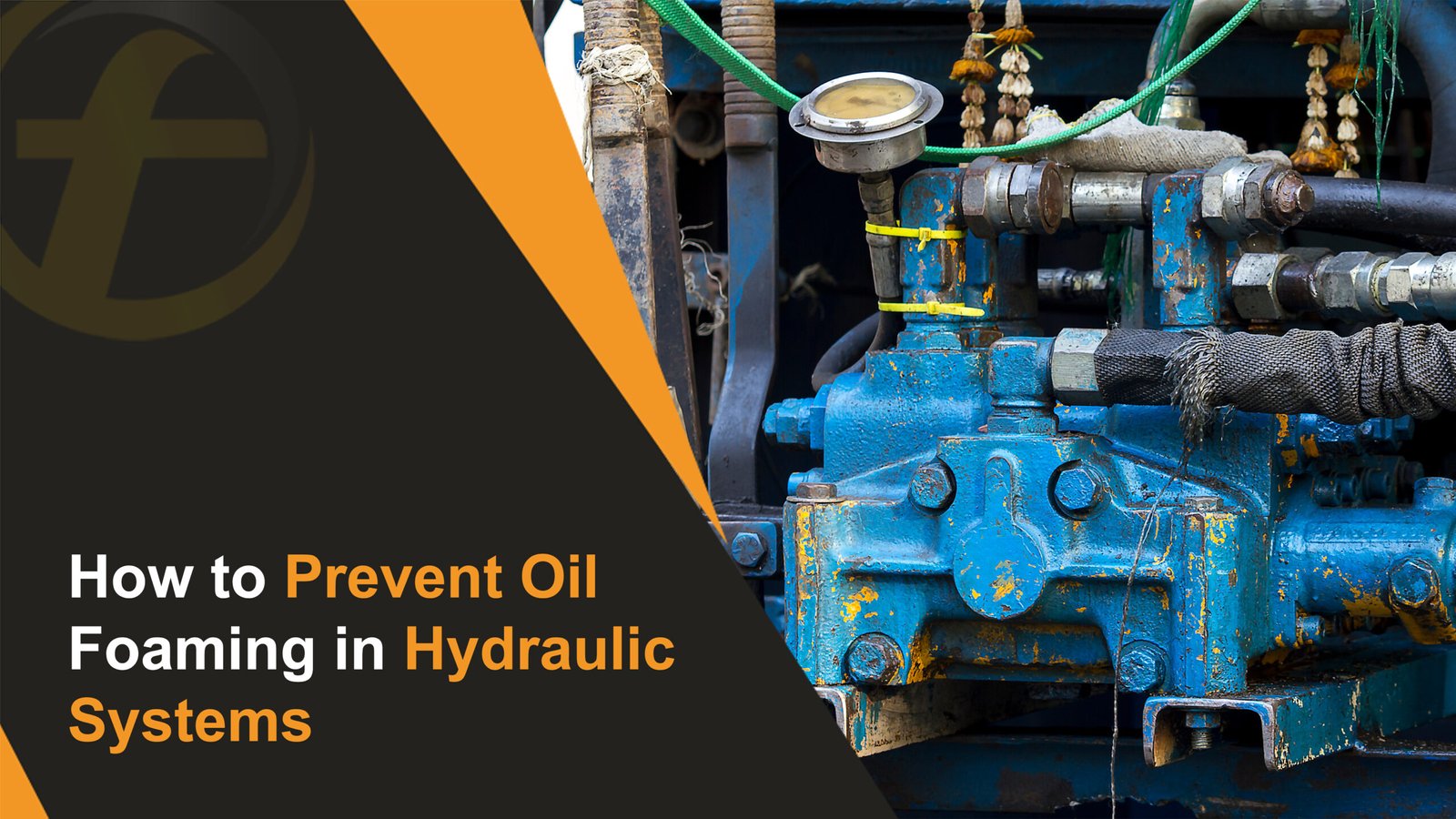
Hydraulic fluid foaming can damage your system’s performance and cause sudden downtime. In severe cases, you might even need a full fluid flush. This can be costly, so using the right hydraulic oil that helps prevent foaming is a smart way to save money on repairs and parts. Fubex Lubricants offers premium hydraulic oils that reduce foaming and protect your machinery. Enjoy fast shipping, price match guarantee, and easy returns. Need help choosing the right oil? Call +971 50 544 9614 — our team is ready to assist!
This guide explains the common causes of hydraulic oil foaming and shares easy tips to help you prevent it.
Key Takeaways:
- Foaming in hydraulic oil can cause poor lubrication, pump damage, and expensive downtime.
- Common causes include air leaks, fluid mixing, wrong or old oil, and too much fluid movement.
- Foam lowers system efficiency, wears parts faster, and increases the risk of overheating and failure.
- Prevent it by using antifoam additives, good reservoir design, regular maintenance, and oil testing.
- Pick hydraulic oil with strong air release, reasonable oxidation control, and foam resistance to keep machines running well.
Hydraulic Fluid Foaming Problems
Foaming in hydraulic fluid, even if minor, can create serious problems. It may cause:
- Reservoir overflow
- Poor lubrication
- Faster aging of hydraulic fluid due to oxidation
- Air is getting trapped in the system.
When air gets mixed into the fluid, it can lead to cavitation and pitting damage. These are among the most harmful issues for your final drive.
How Do Hydraulic Fluid Bubbles Form?
Air bubbles form when air enters or gets trapped in the fluid. Common causes include:
- A sudden drop in pressure, such as at orifices, valves, or where the fluid returns to the reservoir.
- Leaks that create a vacuum in the suction line.
- Contamination from surface-active compounds.
- Contaminants blocking antifoam or air-release chemicals.
- Fluid splashing as it enters the system.
- Poorly designed hydraulic reservoirs.
Where Do Bubbles Usually Appear?
Bubbles can form almost anywhere in the hydraulic system, mainly where pressure drops occur. These include:
- Throttles and orifices
- Valves that open suddenly at the end of a pipe
- Pipe connections and branches
- Areas affected by shockwaves when a pump stops abruptly
What Causes Hydraulic Oil to Foam?
Hydraulic oil can foam for many reasons. Here are some common ones:
- Water, dirt, or grease mixed into the oil
- Using the wrong type of fluid
- Too much air is getting into the oil (this often happens because of a mechanical problem)
- The pump is not working as well as it should
- Using too much defoamant, or the defoamant is worn out
Why Does Hydraulic Oil Foam?
Foaming in hydraulic oil is a common problem in hydraulic machines and systems. It happens for several reasons, including:
- Low-quality hydraulic oil
- Overloading the hydraulic system
- Water mixes with the oil
- Dirt or solid particles in the oil
- Antifoam agent wearing out (often caused by heavy filtration or separation processes)
- Mixing the oil with the wrong type of lubricant
- Using too much antifoam additive because of a bad formula or a wrong refill
- Old or worn-out oil
- Leaks or damage in the hydraulic system that let in too much air
Foaming usually comes from poor oil quality, too much load on the system, or mechanical problems. To prevent it, you should use good-quality oil, check the system often, and service it regularly to keep it in top shape.
8 Key Features of Hydraulic Oil
Hydraulic oils are made using mineral or synthetic base oils (Group III, PAO, or esters) mixed with special additives. These additives improve the oil’s performance and help protect hydraulic systems. When choosing hydraulic oil, it’s essential to focus on eight key features:
- Proper viscosity for the job
- High viscosity index for better stability
- Effective anti-wear additives
- Sludge and varnish control
- Fast air release
- Foam control
- Contamination control
Let’s look at each feature and see why it matters for hydraulic systems.
1. Viscosity
Viscosity means how thick or thin the oil is.
- Oil that is too thin can cause pumps to wear out faster and result in higher temperatures.
- Oil that is too thick can also raise temperatures and increase energy costs.
Most hydraulic systems work best at 13–36 cSt (55–97°F).
2. Viscosity Index (VI)
The viscosity index shows how stable the oil is across different temperatures.
- Mineral oils have a VI of about 95–110.
- Synthetic oils have a VI of 135 or more.
High VI oils protect better in both hot and cold conditions. They flow easily in the cold and stay thick enough in high heat to protect pumps.
3. Anti-Wear Additives
Additives protect parts from wear. Zinc-based additives can be measured in oil tests (in ppm), but zinc-free (ashless) oils cannot be easily measured this way.
Types of hydraulic oil:
- DIN 51524-1: Rust and oxidation protection only
- DIN 51524-2: Adds anti-wear protection
- DIN 51524-3: Adds anti-wear plus high VI (VI > 140)
4. Demulsibility
This is the oil’s ability to separate from water. Water in oil can cause rust and wear. Good demulsibility makes water removal easier, protecting your system.
5. Sludge and Varnish Control
Sludge and varnish can damage valves and shorten equipment life. Synthetic oils naturally resist oxidation, which helps prevent sludge. Oils with anti-varnish additives offer even better protection.
6. Air Release
Air bubbles in oil cause heat and wear. Good air-release properties help oil run cooler and last longer. Poor air release can lead to microdieseling, which damages the oil and causes varnish formation.
7. Foam Control
Foam forms due to contamination, trapped air, or low additive levels. Antifoam additives help bubbles pop, but if the oil is dirty or over-aerated, foam can build up. Excess foam changes oil thickness and reduces protection.
8. Contamination Control
Dirt, dust, water, or wear particles can damage parts and increase maintenance costs.
- Use clean oil from the start.
- Filter oil before and during use.
- Install high-quality breathers to block dirt and moisture.
A sound filtration system helps keep the oil at the ISO cleanliness level recommended by the manufacturer.
Effects of Foaming on Hydraulic Systems
Foaming in hydraulic fluid may seem small, but if ignored, it can lead to severe damage and costly repairs. Here’s how it affects your system:
- Loss of efficiency and unstable pressure – Foam makes the fluid more compressible, reducing system accuracy and smooth operation.
- Poor lubrication and faster wear – Foam weakens the oil’s ability to lubricate, causing more friction and part wear. This increases maintenance needs.
- Cavitation and pump damage – Air bubbles can collapse under pressure changes, creating heat spots that damage pumps and valves.
- Higher temperature and faster oxidation – Foam traps heat, which speeds up oil oxidation and breaks down essential additives.
- Risk of breakdown and downtime – Overheating and damage may cause sudden machine failure, leading to unexpected stops in production.
How to Stop Air From Getting Into Hydraulic Oil
Hydraulic oil can get contaminated when air mixes with it. This can harm the oil and damage other parts of the hydraulic system.
Air can enter the oil in four main ways:
- Dissolved Air: About 6–12% of hydraulic oil naturally contains dissolved air.
- Entrained Air: Tiny bubbles of air, smaller than a millimeter, mix with the oil.
- Foam: Bigger bubbles gather on the surface of the oil, creating foam.
- Entrapped Air: This is the hardest to remove. Free air can usually be taken out during startup by pre-filling parts and properly bleeding the system.
Small amounts of foam are usually not dangerous. But if you see a lot of foam, it could mean there is severe air contamination or that the oil is starting to break down.
What Causes Hydraulic Fluid to Foam?
Foaming in hydraulic fluid is not just a minor problem—it can seriously affect how your system works and how long it lasts. If left untreated, it may cause damage to key parts like the final drive motor.
Foam forms when air bubbles get trapped in the fluid and rise to the surface. These bubbles are usually bigger than one millimeter—about as thick as a credit card. Air often mixes with the fluid from the free surface, and over time, this creates foam.
Foaming is typical in hydraulic systems, but the good news is that it can be fixed with the right oil and proper maintenance.
How to Prevent and Eliminate Foaming
Foaming in hydraulic fluid reduces system efficiency and can lead to costly damage. Preventing it is key to keeping your machinery running smoothly and lasting longer.
Ways to Prevent Hydraulic Fluid Foaming
- Use antifoam additives – These additives break up bubbles before they form foam. Common ones include ester-based and silicone oils.
- Ensure proper reservoir design – A well-designed tank helps air escape before the fluid circulates. It also limits air contamination.
- Follow regular maintenance –
- Vent the system to release trapped air.
- Inspect and replace worn seals to stop leaks.
- Degas the fluid if foaming appears.
- Monitor contamination and oxidation – Test the fluid often. Replace filters, flush old fluids, or repair worn parts when needed.
- Select the proper fluid – Choose hydraulic oil with strong air-release and demulsibility properties. This reduces the chance of air and water contamination and helps your system last longer.
Final Takeaways
Foaming in hydraulic systems may seem like a minor issue, but it can lead to serious problems if ignored. It can cause poor lubrication, higher wear, and even damage to essential parts of your equipment. The good news is, foaming is preventable.
To keep your system running smoothly, always use high-quality hydraulic oil, like that from Fubex Lubricants, which offers foam control, fast air release, and strong contamination resistance. Regular maintenance, and clean oil handling are also key steps to stop air from entering the system.
By choosing the right oil and caring for your hydraulic system, you can avoid costly repairs, improve performance, and extend the life of your equipment.
FAQs
Q1: What Can Stop Oil from Foaming?
To stop oil from foaming, you need to keep water and moisture out. Always dry food before frying and make sure your equipment is dry. Do not overheat the oil because high temperatures can cause foaming and break down the oil. Avoid overcrowding the fryer and remove food crumbs or debris quickly, as they also lead to foam build-up.
Q2: What oil additives prevent foaming?
The most common additives used to stop oil from foaming are silicone-based antifoam agents. One example is polydimethylsiloxane. These additives work because they have very low surface tension, which helps break air bubbles and stop foam from forming on the oil’s surface.

Editor-at-Large
A passionate writer in the lubricant industry, Awais Iqbal has been covering oils, greases, and industrial fluids since the start of his career. At 25, he’s already written for blogs, catalogs, and brand guides across the UAE. Awais’s insights help companies connect with their audience, and his clear, helpful writing style is trusted by brands in the region.


